
On Thursday, August 8, hundreds of Chicago sustainable transportation and environmental advocates joined many City and State elected officials in the Save Our Lakefront Rally outside Truman College in Uptown. They protested the Redefine the Drive plan from the Illinois and Chicago departments of transportation. Their recently announced proposal is to rebuild North DuSable Lake Shore Drive as an eight-line highway with no dedicated transit lanes, continuing to separate residents from the lakefront.
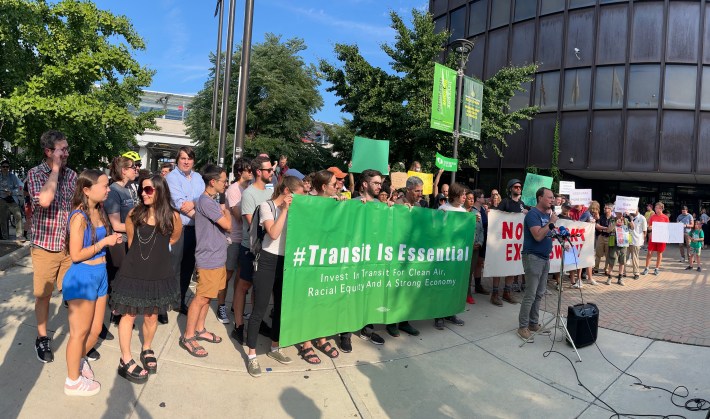
Meanwhile inside the adjacent building, IDOT and DOT held an open house about their plan. After the rally concluded, a large number of participants lined up outside the open house, waiting for their turn to check out display boards and talk to department staffers.
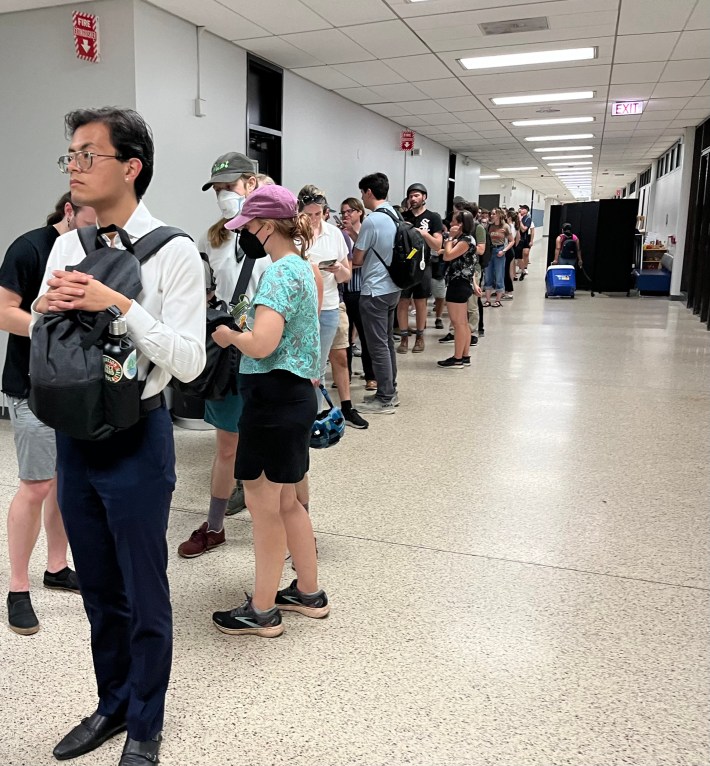
I had the opportunity to talk with Steve Schilke, bureau chief of programming of IDOT Region 1, which covers Chicago and the rest of northeast Illinois' six county region. This interview has been edited for clarity and brevity.
John Greenfield: Obviously this is a remarkable situation right now. You've got a huge flood of people from the rally. In a way, from your perspective, this might be great, because you want to have a lot of community input atmaps your event. So did any of you [IDOT and/or CDOT staffers] attend the rally or listen to it?
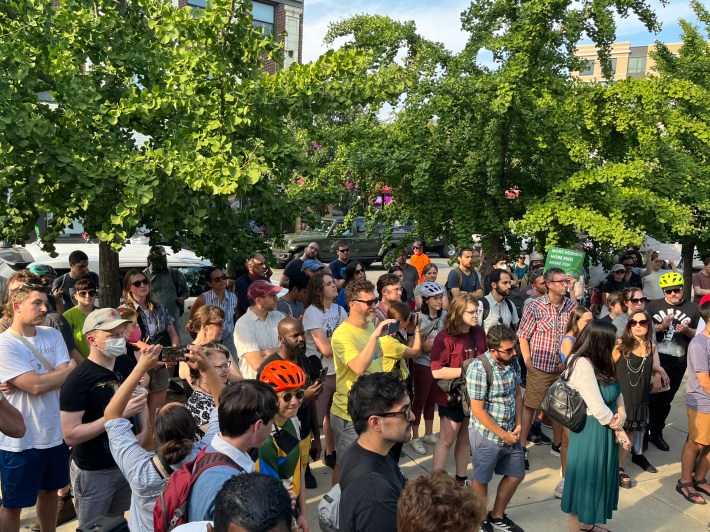
Steve Schilke: I know that there were some that did go out and looked at it and listened to it. I personally looked at and listened to some of the rally. So yes, we certainly want to hear all this feedback.
JG: So the general message of the rally, if you were to pick one thing that people are upset about, it's that the possibility of dedicated transit lanes is no longer on the table...
Today IDOT announced that they have eliminated all four remaining roadway design options that provide a dedicated lane for public transit for #northDLSD They want the “Essential” option, which basically maintains the highway status quo
— Michelle Stenzel (@MichelleStenzel) July 23, 2024
Outrageous
Much more to come on this pic.twitter.com/G1oI3Nb0Bn
SS: Not necessarily, but yeah.
JG: Isn't IDOT recommending "The Essential" scenario?
SS: Yes. Currently we are recommending the The Essential, with transit priority at the junctions, so it would be very similar to the Loop Link downtown. [This express bus corridor gives bus drivers a special signal to pass through some intersections before other vehicle operators get a green light.] So all the alternatives put transit at the forefront.
Now, when you looked at "The Exchange" [one mixed-traffic lane in each direction converted to transit-only], "The Flex" [one lane in each direction reserved for transit and drivers who pay a toll], "The Double Flex" [two lanes in each direction reserved for transit and drivers who pay a toll], and "The Addition" [widening the drive to a monstrous ten lanes to maintain four mixed-traffic lanes in each direction plus transit-only lanes], a lot of those alternatives needed those middle ramps.
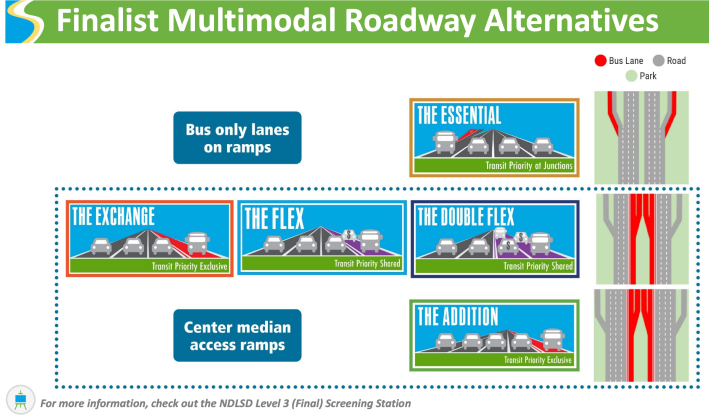
And so when we analyzed it, we saw that we could improve a lot of the transit operations by fixing them at the junctions and keeping the speeds that we're seeing right now with those buses that operate like an express bus today. Their speeds are in the 30-plus mph on average. [Obviously NDLSD express buses aren't averaging 30 mph when they get stuck in traffic jams created by private vehicle drivers.]
That's why we're recommending The Essential. We thought this has the best balance of preserving the parkland and tightening up the [NDLSD] footprint. We heard that a lot: 'Don't make it expressway-like." And when you look at The Exchange, it does look rather expressway-like with those middle lanes coming in, and you have to have ramps everywhere.
The issue that you're having is that, because we're not designing this like an expressway, like the Kennedy or anything like that, when you look at it, the junctions are very close, about a half mile to a mile. If you were to just stripe out a middle lane, then the problem is that the bus has to fight three lanes to get over to the middle and then, "Ah, Fullerton's coming up," they have to get out, or [for buses heading to the Magnificent Mile], "Ah, Michigan's coming up."

It's rather close spacing... When we modeled it, we didn't see a significant transit improvement versus The Essential, so that's why we're recommending it. But we're here to take feedback on it.
JG: Now IDOT and CDOT have said in your final statements that you didn't think there could be a significant shift from car trips to transit trips. But before that IDOT did a survey that found that 60 percent of [NDLSD] drivers would be willing to shift to transit if it was frequent and reliable."
SS: That was a different context of that survey. It wasn't a blanket survey... What we found is that this is a fantastic transit corridor. So within the catchment area of [NDLSD], getting to the Central Business District, 75 percent of the [road] users are already using transit. That is phenomenal. Nowhere else in the city matches that number. So now, if you're looking at improving the service, you're looking at 25 percent more.
JG: Well, the problem with [NDLSD] is that anytime you're looking at the drive during rush hour, you're seeing traffic jams made by single-occupant vehicle drivers, and buses carrying, like, 64 people, are getting stuck. So you haven't really explained why it wouldn't make sense to have a dedicated lane for buses. I heard your argument about having to switch lanes, but there's got to be ways to solve that problem, like with access ramps.
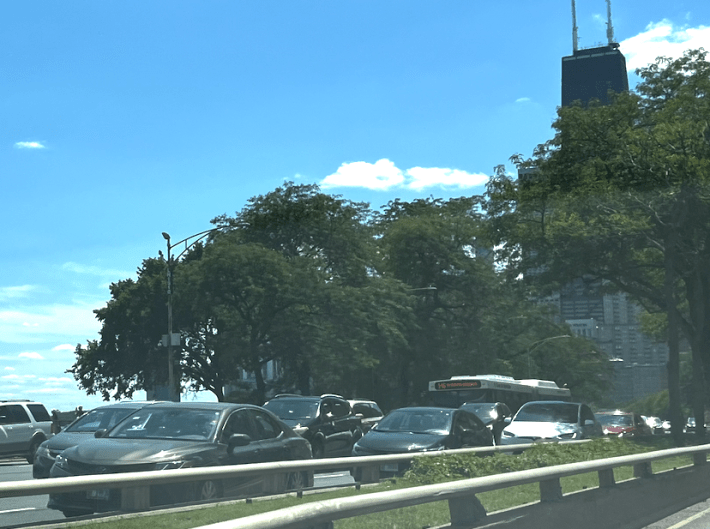
Isn't the basic issue that it takes political courage to convert two of the mixed-traffic lanes to transit-only lanes, and that's considered to be a politically unpopular decision? But what this rally shows is that there actually are a lot of people who do want to see DuSable Lake Shore Drive become less car-oriented, with fewer lanes for drivers, and become more transit-oriented. So do you really feel that giving dedicated lanes to buses wouldn't make a difference?
SS: Well, currently the models are showing that the dedicated lanes with what we're currently doing, there isn't much of a difference in bus speeds between [The Essential and The Exchange]... The Essential is an 8 percent reduction in capacity for cars [due to buses getting dedicated lanes on access ramps at the junctions] and The Exchange is a 25 percent reduction. So those are two benchmarks, and The Flex is in the middle of the two.
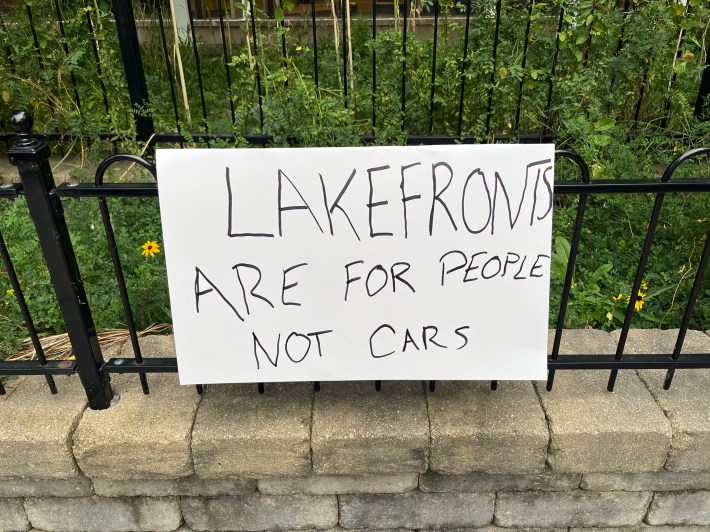
I appreciate Schilke taking the time to discuss this subject with me. But the claim that an NDLSD design with dedicated transit lanes, which would let buses avoid traffic jams, wouldn't make much difference in transit speed, reliability, and ridership compared to a design without them, seems dubious. And surely there are ways to facilitate buses coming and going from the car-free lanes that wouldn't make the road more expressway-like. Perhaps modifying bus routes so that buses get on and off the drive at fewer locations would be helpful.
And while Schilke seemed to imply that The Exchange scenario eliminating 25 percent of NDLSD's car capacity is a defect of that proposal, in reality it's a feature. Not only would the faster, more reliable buses encourage more transit ridership, fewer lanes for motorists would discourage single-occupant trips, which would mean fewer crashes and less pollution.
That's where our priorities should be during at a time when Chicago is trying to achieve Vision Zero and take action to fight climate change. Those issues are more important than worrying about the political consequences of taking lakefront space away from car drivers.
Check out materials from the open house here.

Did you appreciate this post? Please consider making a tax-deductible donation, to help keep Streetsblog Chicago's sustainable transportation news and advocacy articles paywall-free.





